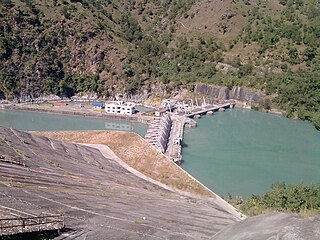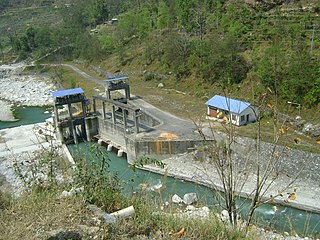
The Kosi or Koshi is a transboundary river which flows through China, Nepal and India. It drains the northern slopes of the Himalayas in Tibet and the southern slopes in Nepal. From a major confluence of tributaries north of the Chatra Gorge onwards, the Kosi River is also known as the Saptakoshi for its seven upper tributaries. These include the Tamur River originating from the Kanchenjunga area in the east and Arun River and the Sun Kosi from Tibet. The Sun Koshi's tributaries from east to west are the Dudh Koshi, Likhu Khola, Tamakoshi River, Bhote Koshi and Indravati. The Saptakoshi crosses into northern Bihar, India where it branches into distributaries before joining the Ganges near Kursela in Katihar district. The Kosi is the third-largest tributary of the Ganges by water discharge after the Ghaghara and the Yamuna.

Kaligandaki A Hydroelectric Power Station is situated near Mirmi of Syangja District about 300 km to the west of Kathmandu and 100 km from Pokhara in the same direction in Nepal. The hydropower project is also the biggest hydropower project of Nepal. The dam and headworks are situated on the Gandaki River at the confluence of the Andhikhola whereas the power house is located downstream, around a bend in the river, in Beltari. A 5.9 km (3.7 mi) long headrace tunnel connects the reservoir to the power station which contains three 48 MW Francis turbine-generators. Owner and operator of the power plant is Nepal Electricity Authority.
The Buk Bijela Hydro Power Plant is proposed hydroelectric power plant (HPP) on the Drina River in Bosnia and Herzegovina.

The Upper Kotmale Dam is located in Talawakele, within the Nuwara Eliya District, in the Central Province of Sri Lanka. The dam feeds the third largest hydroelectric power station in the country.
Mohmand Dam is an under construction multi-purpose concrete-faced rock-filled dam located on the Swat River approximately 37 km north of Peshawar and 5 km upstream of Munda Headworks in Mohmand District, Khyber Pakhtunkhwa, Pakistan.

Renewable energy in Nepal is a sector that is rapidly developing in Nepal. While Nepal mainly relies on burning biomass for its energy needs, solar and wind power is being seen as an important supplement to solve its energy crisis. The most common form of renewable energy in Nepal is hydroelectricity.

PJSC «Ukrhydroenergo» is a Ukrainian state-owned enterprise that administers many major hydro power plants along the Dnieper and Dniester rivers. It is Ukraine's main hydropower generating company. It is capable of covering peak loads and providing FCAS for the United Energy Systems of Ukraine (UESU). Hydroelectricity is a renewable energy source, and does not require the combustion of fossil fuels in its operation. The company operates ten power plants on the Dnieper and Dniester rivers: Kyivska HPP, Kyivska PSP, Kanivska HPP, Kremenchutska HPP, Seredniodniprovska HPP, Dniprovska HPP No. 1, Dniprovska HPP No. 2, Kakhovska HPP, Dnistrovska HPP, and Dnistrovska PSP. Enabling works are underway at Kanivska PSP and Kakhovska HPP No. 2.
The Dasu Dam is a large hydroelectric gravity dam currently under construction on the Indus River near Dasu in Kohistan District, Khyber Pakhtunkhwa Province, Pakistan. It is developed by Pakistan Water and Power Development Authority (Wapda), as a key component of the company's Water Vision 2025. The project was started in 2019 but faced a delay due to funds and land acquisition disputes. Work resumed in 2020 after land acquisition and arrangements of funding facility, the World Bank agreed to contribute $700 million of the $4.2 billion as the government of Imran Khan decided to proceed ahead with the construction of the project, as part of the WAPDAs vision 2025.
Chilime Hydropower Plant is hydro power plant in Nepal.
Panauti Hydropower Station is the third hydropower station which was constructed in Nepal, in 1965. It is the first megawatt (MW) capacity hydropower station in Nepal.
The Upper Karnali Storage Hydropower Project is a proposed run-of-the-river hydroelectric plant on the Karnali river in Nepal. It will have an installed capacity of 900 MW, making it the largest hydropower plant in Nepal when achieved. However, most of the generated power is set to be exported to both Bangladesh and India, via a 400 kV double circuit transmission line, with the only remaining 108 MW of total power dedicated to local consumption.

The Upper Tamakoshi Hydroelectric Project is a 456 MW peaking run-of-the-river hydroelectric project in Nepal. It is the largest hydroelectric project in Nepal, operating since July 2021. It is sited on the Tamakoshi River, a tributary of the Sapt Koshi river, near the Nepal–Tibet border.

Nepal is a country enclosed by land, situated between China and India. It has a total area of 148,006.67 square kilometers and a population of 29.16 million. It has a small economy, with a GDP of $33.66 billion in 2020, amounting to about 1% of South Asia and 0.04% of the World's GDP.

Koshi Province is the autonomous easternmost province adopted on 20 September 2015 by Constitution of Nepal. The province is rich in natural resources, tourist attractions, recreational activities, and natural beauty. The province covers an area of 25,905 km2 (10,002 sq mi), about 17.5% of the country's total area. With the industrial city of Biratnagar as its capital, the province includes major eastern towns of Birtamod, Sundar Haraincha, Damak, Dharan, Itahari, Triyuga Municipality and Mechinagar, and the Mount Everest, Kangchenjunga and Ama Dablam. Koshi River, the largest river of the nation, forms the province's western boundary. Under the First-past-the-post voting system issued by the Constituency Delimitation Commission, Nepal, the province hosts 28 parliamentary seats and 56 provincial assembly seats.

The power generation potential of the rivers in Azerbaijan is estimated at 40 billion kilowatt per hour, and feasible potential is 16 billion kilowatt per hour. Small-scale hydro has significant developmental potential in Azerbaijan. In particular, the lower reaches of the Kura river, the Aras river and other rivers flowing into the Caspian Sea. Hydropower could conceivably provide up to 30% of Azerbaijan’s electricity requirements. Currently, hydropower, dominated by large-scale dams, provides 11.4% of Azerbaijan’s electricity.
Nuwakot Solar Power Station is located at Nuwakot District of Nepal. It is the largest solar power plant of Nepal. The plant is owned by Nepal Electricity Authority (NEA). The solar panels are installed in six locations within the premises of Devighat Hydropower Station which is also owned by the NEA. Energy generated by the project is connected to the 66 kV sub-station of Devighat Hydropower Station. The solar station generates energy only during the daytime.
Budhiganga Hydropower Project is a peaking run-of-river type located at the Achham and Bajura districts of Nepal. The headworks of the project is located in a narrow gorge below Rakse Khand. All major project structures are located on the left bank of the river. The project site is about 890 km west of Kathmandu. The design flow is 27.63 m3/s and gross head is 90 m giving an output of 20 MW and annual average energy of 106.28 GWh. The peaking capacity is 0.236 Mm3. The waterways consist of 5.6 km long tunnel.

Modi Khola Hydroelectric Power Plant is a run-of-river hydro-electric plant located in Parbat district of Nepal. The flow from Modi River is used to generate 14.8 MW electricity. Annual energy generation capacity is 92.5 GWh. This power plant began operating in 2000 and is owned by the Nepal Electricity Authority (NEA).
Daraundi A Hydropower Station is a 6 MW run-of-river hydro-electric plant located on the Daraundi River in the Gorkha District of Nepal.










